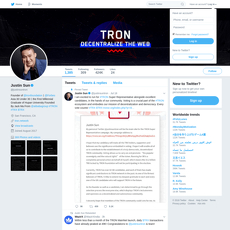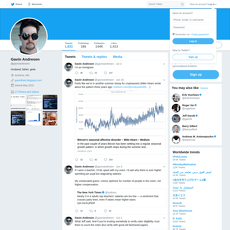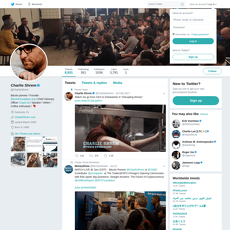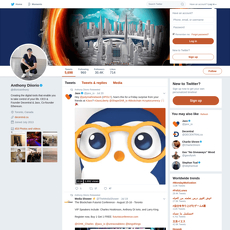Nicola Duke Review
Nicola Duke
twitter.com
Nicola Duke (@NicTrades) Review Guide: Everything You Need to Know + FAQ
Ever catch yourself scrolling through Twitter, seeing a clean chart, and thinking, “Should I just take this trade?” If you’ve been eyeing @NicTrades and wondering whether following a trader on X/Twitter can actually improve your crypto results, you’re in the right place.
I’ve spent a lot of time testing crypto tools and listening to market voices so you don’t have to. My goal here is simple: show you what you really get from Nicola Duke’s feed, how to use it without risking your stack, and whether she’s worth your time.
Why crypto traders get stuck on Twitter
Crypto Twitter can be a maze. One minute you’re seeing a bullish breakout call; the next, someone’s posting a doom chart. Mixed strategies, vague drawings, and hot takes make it easy to overtrade or freeze—especially if you’re trying to build a plan from scattered screenshots.
- Mixed signals: Different timeframes and strategies collide in your feed. It’s hard to know which idea fits your approach.
- No invalidation: Many charts don’t say where the idea is wrong. Without a clear “I’m out if X happens,” risk spirals fast.
- Hype loops: Big targets grab attention; risk controls don’t. Social algorithms reward bold calls, not careful planning.
- Copy-trading traps: Timing a tweet is not the same as timing a trade. Research consistently shows retail traders tend to overtrade and chase attention, which hurts returns (Barber & Odean; Da, Engelberg & Gao).
“Clear levels, context, and realistic expectations—those are the antidotes to feed-driven FOMO.”
What you’ll get here
I’ll break down who Nicola Duke is, what she posts, how credible it feels, and practical ways to use her work. I’ll also include the questions traders ask most so you can make a confident decision today—without guessing.
Who this is for
- Crypto traders who like technical analysis and level-based planning.
- Beginners who want structure without hype and advanced traders who want a clean second opinion.
- Anyone sanity-checking which influencers are actually worth a follow.
Quick disclaimer
Nothing here is financial advice. Markets change, and so do social feeds. This is an independent, good‑faith review based on recent observations and long‑term experience watching analyst accounts. Always use your own risk rules.
How I evaluated @NicTrades
I paid attention to how usable her work is for real trading, not just how nice the charts look. Here’s the lens I used:
- Posting patterns: Does she update when price approaches key areas or when invalidation hits?
- Chart style: Are levels and structures obvious, or do you need a decoder ring?
- Risk framing: Are invalidation points or “this is wrong if…” statements clear enough to anchor stops?
- Level clarity: Can you translate her zones into alerts and scenarios without guesswork?
- Practicality across timeframes: Do the charts help both swing traders and intraday watchers, or only one group?
Real talk: a good analyst account should help you plan. For example, if Bitcoin is approaching a well-defined resistance cluster, a helpful post marks the level, the invalidation, and the context—so you can set alerts, plan a break/retest, or stand down if the level rejects. That’s the kind of value I looked for when assessing @NicTrades.
Curious about her background, market focus, and posting tone before you commit to the follow button? That’s exactly what I’m covering next—want the quick, no‑fluff profile so you can decide fast?
Who is Nicola Duke (NicTrades)?
Nicola Duke, known as @NicTrades on Twitter, is a technical analyst who keeps things simple and level-focused. If you like charts that tell you exactly what zone matters and where you’re wrong, her work fits that mold. No empty hype—just structure you can act on.
“Clarity beats hope when your money is on the line.”
Quick bio and focus
Her priority is clear, rule-based technical analysis. Think support/resistance, trend structure, and invalidation—not moon calls or drama. When she posts a chart, it usually answers three questions fast: where price is, where it could go, and where the idea is invalid.
- Levels first: Clean horizontals, prior highs/lows, range boundaries.
- Fibonacci as a map: Zones like 0.618 retracements or 1.272–1.618 extensions to frame targets and traps.
- Context matters: She blends higher timeframe structure with actionable intraday zones when it’s relevant.
- Risk language: Invalidation is part of the post, not an afterthought.
That last point is a big deal. Traders who define invalidation upfront typically take smaller average losses and avoid the “hold and hope” spiral. There’s plenty of research showing disciplined risk rules matter more than hot takes—momentum and trend effects are real, but without stops, edge leaks fast.
Markets she covers
Expect a crypto-first lens, with a steady focus on the majors and a few key alts when they’re moving.
- Bitcoin (BTC): Weekly structure for the big picture, with intraday checkpoints when price tags important levels.
- Ethereum (ETH): Often mapped with the same level logic—range edges, retests, invalidation lines.
- Major alts: Selective, typically when a chart lines up with clear structure rather than chasing every ticker.
- Broader context: You may see notes that anchor crypto moves to market conditions when it helps refine timing.
Her angle shifts with volatility. When the market’s trending, you’ll often see continuation zones and pullback levels. In chop, it’s more about range edges and patience, which helps keep you from forcing trades in the middle.
Posting style and tone
The tone is calm and chart-centric. Posts are concise, with visuals that highlight the areas that matter. You won’t see sensational predictions—just “here’s the plan if X, here’s the risk if Y.”
- Clean charts: Key horizontals labeled, fib zones shaded, invalidation marked.
- Two-sided planning: Break-and-hold vs. reject-and-retrace scenarios so you’re not married to one bias.
- Timeframe layering: Higher timeframe levels set the bias; lower timeframes decide execution—without mixing signals.
For example, if BTC approaches a weekly range high, she’ll often outline two paths: acceptance above with a retest that holds, or rejection back to the range mid. That keeps you prepared either way—less guessing, more reacting.
Where to follow
Her main home is Twitter: https://twitter.com/NicTrades
- Verify the account: Handle spelled exactly “NicTrades.” Watch for impostors with similar names.
- Check recency: Consistent, current posting is a good sign you’re on the real profile.
- Stick to official links: Only trust links she shares on that verified feed.
If you’re wondering what you actually get by following—how often she posts, what the charts look like, and how to read them without guessing—I’ll walk you through that next. Want clear examples you can turn into alerts and plans?
What you actually get by following @NicTrades
If you’re tired of vague “moon” arrows, her feed feels like stepping into a quiet room with a clean map on the wall. You’ll see price levels that matter, the invalidation that kills a setup, and enough structure to plug straight into your plan—without hype.
“Good trading is less about being right and more about knowing exactly what to do when you’re wrong.”
What her posts look like on your feed
- Support/Resistance zones: Clear bands where buyers or sellers have shown up before. Great for building scenarios A/B.
- Fibonacci levels: Common retracement zones (like 0.382 or 0.618) used as confluence with structure—especially on BTC and ETH.
- Trend structure notes: Higher highs/lows or broken structure so you know which side has momentum.
- Invalidation markers: The line in the sand. If price crosses it, the idea’s off. Think of these as risk anchors, not guarantees.
When she tends to post
Expect more updates when price is pressing into a key area or structure shifts. It’s not a “signal every hour” kind of feed—it’s “here’s the zone, here’s what flips the script.” During choppy periods, you’ll see fewer posts and more focus on levels worth waiting for.
How to read her charts like a pro
- Start with timeframe: Is it a 4H or a Daily chart? Treat intraday levels differently than weekly anchors.
- Copy the levels to your chart: Draw the zones she marks so your alerts and plans live on your screen, not in your head.
- Mark invalidation: If price trades through the line she labels as invalid, don’t “hope.” That’s your exit plan.
- Check confluence: Do you see a Fib level lining up with a prior swing high/low or a moving average? Multiple signals at one price = stronger plan.
- Build two routes:
- Scenario A: Rejection from resistance → short bias, tight risk above invalidation.
- Scenario B: Clean break and retest → long bias, risk under the retest low.
- Set alerts, not hopes: Use TradingView alerts at her levels and the invalidation line. Reaction > prediction.
- Size like a pro: Many traders cap a single trade’s risk to a small fixed percentage—consistent sizing keeps one idea from wrecking your week.
Practical examples you can use today
- BTC at a prior weekly high: She highlights the old range high as resistance and marks invalidation just above. I set two alerts: one slightly below (to watch for rejection), one slightly above (to plan a break-and-retest). If rejection prints with strong wicks, I plan shorts with risk above invalidation. If we close above and retest the level as support, I flip long with stops under the retest low.
- ETH into a 0.618 retracement: Price pulls back into 0.618 that lines up with a 4H demand zone. I map a trigger candle (e.g., strong bullish close) and place risk under the zone. If invalidation hits, I’m out—no averaging. If it holds, I scale partials at the next resistance she marked.
- BTC range consolidation: She outlines a tight range with a midline. I plan a “fade extremes, respect midline” approach: sell near range highs, buy near lows, reduce size if midline fails, and drop the plan entirely on a decisive range break.
These aren’t “signals”—they’re templates. You plug your trigger rules and risk parameters into her structure. That’s the edge: clarity before entry.
Quick wins from following her
- Set focused alerts: Put alerts exactly where her zones sit to avoid chasing candles.
- Refine your watchlist: Only track pairs with clean structure and clear invalidation.
- Pressure-test your bias: If your idea conflicts with her invalidation, ask yourself why. If you can’t answer, stand down.
- Journal outcomes: Screenshot her level, your plan, and the result. Patterns emerge fast when you track them.
What you won’t get (and why that’s a good thing)
- No constant scalp “signals.” It’s a level-first map, not a copy-trade feed.
- No PnL flexing or lottery targets. Less noise, more structure.
- No hand-holding in replies. The charts are clear; execution is on you.
Why level-based posts work for many traders
There’s real-world backing for this kind of map-making. Research on market microstructure shows orders cluster at obvious levels (prior highs/lows, round numbers), which is why reactions often spark there. Reviews of technical rules in liquid markets have also found periods where simple level or trend rules can outperform—especially when paired with disciplined risk control. Crypto’s order flow tends to magnify those behaviors during volatility, which makes a clean levels-first feed surprisingly practical.
Community and replies
Expect a measured, professional tone. She answers selectively, keeps charts tidy, and avoids drama. It’s perfect if you’re self-directed and prefer “here are the lines—execute your plan” over back-and-forth coaching.
I like clarity, but clarity isn’t the same as trust. Are the levels consistent, is invalidation respected publicly, and what risks should you watch for with any influencer—no matter how good the charts look? Let’s look at that next.
Credibility check: track record, transparency, and risks
Trust on crypto Twitter isn’t about who shouts the loudest; it’s about who respects invalidation, keeps a steady process, and doesn’t sell you certainty. With @NicTrades, I look for clear levels, consistent logic, and how she responds when a level breaks. That’s where the truth shows up.
“Clarity beats certainty. Invalidation isn’t giving up—it’s respecting reality.”
Not financial advice—just how I evaluate analyst accounts.
What she emphasizes (and what she doesn’t)
- Emphasizes: level-based thinking, structure, and invalidation. You’ll often see zones, Fibonacci confluence, and “invalid below/above” markings that make risk concrete.
- Doesn’t push: daily PnL flexes, spray-and-pray signals, or “10x by Friday” threads. It’s process-first, not hype-first.
Why that matters: levels with explicit invalidation are teachable and testable. You can set alerts, plan scenarios, and avoid the trap of “it still looks fine” when price clearly says it isn’t.
How I assess quality
- Timely invalidation updates: if price closes through a marked level, I want to see that acknowledged and the plan adjusted. No goalpost-moving.
- Consistency across markets: the same TA lens applied to BTC, ETH, and majors—support/resistance, prior swing points, and Fib structure—not a new magic indicator every week.
- Alignment with visible structure: do the zones line up with obvious weekly/daily levels many traders watch? If so, they’re more likely to attract liquidity and matter.
- Zones over single numbers: markets turn in areas, not at exact pixels. I rate charts higher when they respect ranges and “first trouble areas.”
Try this quick audit: take any three recent charts, note the invalidation zone, and check 24–72 hours later if there’s a follow-up when price violates it. That simple loop measures transparency and responsiveness better than any cherry-picked win thread.
Track record realities (and what actually matters)
Few analysts on Twitter publish audited returns. So I tune out grand claims and focus on behaviors tied to risk-adjusted success. There’s research to back that approach:
- Stop-loss rules reduce tail risk: Academic work (e.g., Kaminski & Lo, “When Do Stop-Loss Rules Stop Losses?”) finds stop-losses can cut large drawdowns, though they can add whipsaw. That’s the trade—smaller tails for more scratches.
- Momentum and structure matter: Long-run studies on time-series momentum (Hurst, Ooi, Pedersen) show trend alignment has edge across markets. Level-based charts are a practical way to ride that idea without overfitting.
- Social sentiment is noisy: Research (Bollen et al.) suggests social mood can move markets, but signal-to-noise is messy. Structured TA beats raw crowd emotion.
So I care less about “perfect calls” and more about a repeatable method: clear levels, planned invalidation, and acceptance when an idea is wrong. That’s the DNA I look for on her feed.
Transparency touchpoints I watch
- On-chart invalidation: not vague “might turn soon,” but a visible line or zone where the idea is done.
- No hindsight edits: new posts to reflect change, not quiet deletions or “as expected” after the fact.
- Process reminders: notes that this is analysis, not signals; encouragement to manage risk.
- Stable tooling: similar frameworks over time—Fibs, S/R, structure—rather than shifting narratives.
In my experience, Nicola Duke lands closer to the “clean process” side of that spectrum—levels, structure, invalidation—without the constant outcome-bragging that usually signals trouble.
Risks and how to contain them
- Copy-trading mismatch: your entries, size, and timeframe won’t match hers. Convert any chart into your own trigger, stop, and position size rules.
- Timeframe conflict: reading a daily level and trading it like a 5-minute scalp is how accounts vanish. Align your timeframe or pass.
- Partial context: a tweet is a snapshot. Wait for closes, retests, or confirmation before acting.
- Bias confirmation: only seeing charts that agree with you. Force a “what invalidates my idea?” line in your journal.
- Overconfidence: classic behavioral pitfall—Barber & Odean showed frequent traders often underperform due to overconfidence. Keep size honest.
Red flags to watch with any influencer
- Deleted calls or quietly edited images when wrong.
- “90% win rate” or “no losing weeks” claims without third-party verification.
- Pushy DMs, VIP signal upsells, or “exact entry now” instructions.
- Undisclosed affiliations or paid shills for high-risk products.
- Every outcome reframed as “called it” after the fact.
None of those scream “structured TA.” They scream “marketing.” If you see them, walk.
Bottom line from my review
Good fit if you’re level-driven and want a calm map of the battlefield. Not a signal service. You’ll still need your own entries, stops, and sizing. The value is in the clarity: marked zones, invalidation, and structure you can turn into your own rules. In a sea of shouting, a clean chart can feel like a deep breath.
Thinking about whether the free feed is enough—or if any paid education is worth it? Ever bought a “course” that felt like repackaged tweets? Next, I’ll show you how to tell what’s genuinely useful, what to confirm before you pay, and how to squeeze the most out of the free stuff without missing a trick. Curious what I check before spending a single dollar?
Education, products, and costs
I’ll keep this practical. Offerings change, so the safest move is to check her official links and only trust what’s shared from the verified Twitter account. The free feed already gives you enough structure to learn—if you actually work the levels and track outcomes.
“Clarity is cheap; certainty is expensive. Pay for depth, not promises.”
Free vs paid value
Free (Twitter) — what you can realistically get without spending a cent:
- Clean levels you can turn into alerts and scenarios.
- Invalidation language that trains you to think in risks, not opinions.
- Repeated exposure to structured charts that sharpen your eye for high‑value zones.
- Education by osmosis: see how levels evolve across days/weeks and how invalidation shifts.
Paid (if available) — what’s typically behind a paywall with level‑based educators:
- Deep dives into Fibonacci confluence, structure mapping, and when to ignore a level.
- Case studies: before/after walkthroughs with “what invalidated” and “what confirmed.”
- Repeatable checklists for planning sessions, plus common failure patterns to avoid.
- Format may be masterclasses, recorded modules, live sessions, or a private feed. Always confirm details first.
If you’re deciding whether to pay, ask yourself: do you want someone else’s signal—or a system you can run without hand‑holding? The best paid content helps you build the latter.
Who benefits most
- Swing and intra‑day planners who love clear zones and objective invalidation.
- Self‑directed traders who can execute without “Enter now!” pings.
- Beginners with discipline who learn faster from structured examples than from hype.
- Experienced traders looking to pressure‑test bias with an external, calm framework.
What to confirm before paying
- Scope: exactly which markets/timeframes and how much depth per module.
- Delivery: live vs recorded, session length, and access window (lifetime or time‑limited).
- Support: Q&A, homework reviews, or community forums—what’s included, what’s not.
- Materials: chart templates, checklists, case studies, and session replays.
- Refund policy: terms, timelines, and any conditions you must meet.
- Updates: whether content is refreshed as market structure evolves.
- Expectations: disclaimers about results—no performance promises, ever.
- Security: purchase links must come from the verified Twitter.
Why so picky? Because research shows most retail traders overtrade and under‑plan. Barber & Odean found that higher trading frequency erodes returns (Trading Is Hazardous to Your Wealth). Good education slows you down and forces rules, which is the real edge.
And when you’re evaluating “strategy edges,” keep data‑snooping risk in mind. It’s easy to cherry‑pick a few great chart examples; it’s harder to show a process that survives many markets (see White’s Reality Check for Data Snooping). That’s why I look for modules on invalidation and scenario planning—not just highlight reels.
If you prefer to stay free
Running a zero‑cost plan? Here’s a simple, effective routine that uses only the public feed:
- Set alerts around the posted zones; no alerts, no trades.
- Paper‑trade the first 10 interactions: note entry idea, invalidation, and outcome.
- Journal with screenshots before/after. Track R multiples, not just win/loss.
- Pair with one tool you already trust (e.g., RSI or a 20/50 EMA) to avoid indicator soup.
- Run weekly reviews: which levels were respected? Which failed fast? What was the tell?
If you want to go a notch deeper without paying, structure your learning with spaced repetition—revisit the same pattern across weeks. The spacing effect is well‑documented to improve retention and skill building (Cepeda et al., 2006).
One more sanity check before you buy anything: are you already getting consistent, logged results using just the free levels? If not, a course won’t fix discipline. It can sharpen your process, but it won’t trade for you.
Want the exact rules I use to turn clean levels into entries, stops, and position size—without second‑guessing? Keep going; the next section lays out the step‑by‑step playbook you can put to work today.
How to use @NicTrades without blowing up your account
Good levels are a starting point, not a green light. If you want her charts to actually help (and not turn into a YOLO button), you need a ruleset you can execute on autopilot—especially when price moves fast.
Build rules around her zones
Here’s a simple, repeatable playbook I use around clearly marked levels and invalidation:
- Pick one trigger per setup. Examples:
- Break-and-retest: 1H or 4H close above a level, then a retest that holds.
- Rejection: Wick into the level and close back below/above it on your chosen timeframe.
- Candle confirmation: Engulfing or strong momentum candle off the zone.
- Stops at invalidation, not at feelings. If she marks invalidation below a support, your stop goes a bit beyond that structure, not “where it feels safe.” A simple rule: place stops 0.8–1.2x ATR(14) beyond the level on your execution timeframe to account for noise.
- Pre-size the trade. Decide risk first, then size. Risk per trade: 0.25–1.0% of account until you’ve got data on yourself.
- Formula: Position size = Dollar risk / Stop distance.
- Example: Account $5,000. Risk 1% = $50. ETH level at $3,000 with invalidation at $2,960 (stop $40). Position size = $50 / $40 = 1.25 ETH. If that notional feels big, lower risk to 0.5% or choose a smaller product (e.g., smaller perp or spot size).
- Targets and exits. Pre-plan a base case (e.g., scale 50% at +1R, trail the rest behind structure or 1x ATR). This keeps you from turning winners into break-evens.
- OCO everything. Use one-cancels-the-other orders: entry + stop + target. Remove “decision time” from the heat of the moment.
Quickstart: “If price closes above X on 1H, I’ll bid the retest with a stop 1x ATR below invalidation and risk 0.5%. First take-profit at +1R, trail the rest behind higher lows.”
Backtest and journal
If you don’t collect your own stats, you’ll end up copying random setups and calling it “intuition.” That’s how accounts leak. Keep it tight and mechanical:
- Manual backtest: Use TradingView’s replay on your chosen pair/timeframe. Log 30–50 trades using the exact rules above. You’re testing your execution with her zones, not trying to optimize ten indicators.
- Track the right metrics: Win rate, average win (R), average loss (R), expectancy, and max drawdown. Van Tharp’s expectancy framework is simple and works: Expectancy = (Win% × Avg Win) − (Loss% × Avg Loss).
- Journal template:
- Pair, timeframe, date/time
- Level and trigger (e.g., 4H break-and-retest)
- Entry, stop, target(s), R multiple
- Outcome and screenshot
- One improvement for next time
- Why this matters: Research on trader behavior (Barber & Odean, 2000) shows overtrading and emotional decisions crush performance. A rules-based journal reduces “I feel like it” trades and helps you size correctly. ATR and structure-based exits are supported across systematic trading literature (Kaufman; Clenow) for dampening noise.
Tools and alerts
Make the platform do the watching so you don’t chase every candle.
- TradingView alerts: Drop horizontal lines on her key levels and set alerts for “bar close” conditions (e.g., close above X on 1H). Polyline drawings won’t alert—use horizontals.
- Scenario alerts:
- “Close above 27,400 on 1H” (potential break)
- “Crossing down 27,400” (possible failed breakout)
- “Crossing up ATR stop line” (for trailing)
- Twitter notifications: Turn on notifications for @NicTrades. Then time-block: only act during your chosen execution windows (e.g., top of the hour for 1H charts). This cuts impulsive mid-candle entries.
- Order discipline: Use limit orders on retests when that’s your trigger; market-in only if your plan explicitly allows momentum entries. Always attach stop and target on entry.
- Kill switch: Daily stop (e.g., −2R) or a “two-rule break” exit (if you break two rules in a session, you’re done). It’s amazing how many drawdowns vanish with this one habit.
Common mistakes I see
- Copy-trading without a stop. Invalidation is the whole point of level-based trading. If you ignore it, you’re not using the method—you’re gambling.
- Timeframe mashups. Planning on 4H and executing off a 1-minute chart = whiplash. Anchor on one analysis timeframe (e.g., 4H), and one execution timeframe (e.g., 1H). No mixing beyond that.
- Oversizing because “the level is obvious.” The market punishes confidence without stats. Keep risk per trade small (0.25–1%). Basic risk-of-ruin math (Vince) shows how quickly large risk per trade can end an account, even with a decent edge.
- Front-running the level. Entering “just before it breaks” invites chop. Wait for your trigger: close, retest, or confirmation candle—whichever your plan demands.
- Moving stops to “give it room.” If structure breaks, the idea is invalid. Taking the small loss is the edge. Reset and wait for the next setup.
- Trading news with a technical plan. CPI/FOMC/ETF headlines can blast through levels. If you’re not specifically trading event volatility, step aside or halve size.
- Ignoring costs. Funding, fees, and slippage matter. A +1R that nets +0.6R after costs changes your expectancy. Track net outcomes in the journal.
Want to know how her accuracy stacks up, what she offers beyond Twitter, and whether beginners can follow without getting wrecked? I’ll answer those hot-button questions next—what’s the one thing you should check before you ever pay for any “pro” analysis?
FAQ: key questions people ask about Nicola Duke (@NicTrades)
Is Nicola Duke legit and worth following?
Short answer: yes, if you like clean, level-driven technical analysis and you’re willing to run your own risk plan. She’s been consistent for years with a process-first style—levels, invalidation, structure. No lottery-ticket vibes.
What I look for (and see): clear invalidation on charts, consistency in how she treats structure, and no “guaranteed” calls. That’s exactly the kind of guardrail you want on crypto Twitter.
Just make sure you’re following the real account. Check for:
- Cross-links from known traders she interacts with regularly
- Long history of posts and charts (impostors won’t have depth)
- Pinned posts or official links she repeats over time
What strategy does she use, and can beginners follow?
Expect support/resistance, Fibonacci retracements/extensions, and trend structure. It’s not “signals.” It’s a map with if/then logic—great for planning, especially if you already use TradingView or similar tools.
Beginners can absolutely learn here—just don’t copy-trade. Start with paper trades and journal your decisions. A simple way to test her levels without risking your stack:
- Set alerts at her marked zones
- Wait for your trigger: e.g., a 1h close through the level, or a break/retest with a higher low/lower high
- Place a stop at her invalidation, not where it “feels” right
- Risk small (0.25%–0.5% per idea) until you’ve got 20–30 logged trades
Why this works: multiple studies show traders get hurt most by overtrading and poor risk sizing, not by being “wrong” on direction. See Barber & Odean on retail overtrading and underperformance.
What about accuracy, paid groups, and timing?
Accuracy varies—like any trader. The edge is in how you manage invalidation and position size. Don’t score “right vs wrong”; score R-multiples and drawdown. A 40–50% win rate can still print if losers are cut tight and winners run.
On paid offerings: they change over time. Only trust links she posts on the official Twitter. If you ever get DMs with “special access,” assume it’s a fake.
On timing: she’s more active around meaningful market levels and volatility, not 24/7. That’s a positive. Constant signals usually mean noise. If you want to be ready when she posts, set alerts at her levels so you’re not glued to a feed.
One more reality check: social feeds can influence short-term flows, but the effect decays quickly. Research on Twitter sentiment finds it can correlate with near-term returns/volume, but it’s not a stand-in for strategy (e.g., Bollen, Mao & Zeng, 2011; Sprenger et al., 2014).
Conclusion and final take
If you want calm, structured charts that focus on levels and invalidation, she’s a strong follow. Use the feed like a professional would:
- Plan scenarios at her levels and predefine your triggers
- Respect invalidation—no “one more chance” trades
- Size small and journal every decision
A quick example of turning one of her charts into a plan:
“BTC resistance 49k–49.6k. Invalidation above 49.9k.”
I set alerts at 49k and 49.6k. If 1h closes above 49.9k, I wait for a retest of ~49.6k that holds, enter long, stop at 49.3k, target prior highs and a 1.5–2R first take-profit. If price rejects 49.6k and prints a lower high, I consider a short with stop above 49.9k. Either way, the invalidation drives the risk.
That’s the mindset. Use her charts to plan, not to gamble. If level-driven trading fits your style, follow her, set alerts, and see how it meshes with your system—carefully and with risk under control.
CryptoLinks.com does not endorse, promote, or associate with Twitter accounts that offer or imply unrealistic returns through potentially unethical practices. Our mission remains to guide the community toward safe, informed, and ethical participation in the cryptocurrency space. We urge our readers and the wider crypto community to remain vigilant, to conduct thorough research, and to always consider the broader implications of their investment choices.













